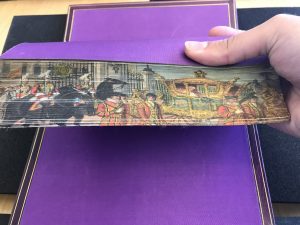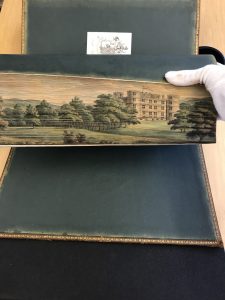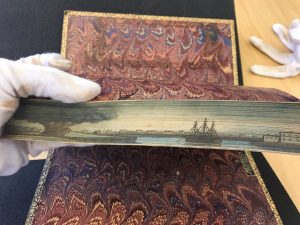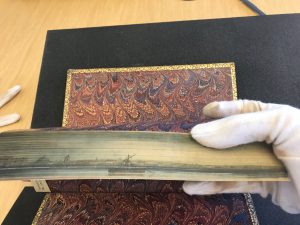I arrived in Museum Studies class on the first day of the semester having little to no knowledge about the mysteries that lie behind the scenes at a museum. However, according to my parents, I have been fascinated by museums since the age of three. In 1999, my family visited Italy and took my sister and I to the Vatican Museums. Apparently, I was so mesmerized by the art I came home from that trip with an imaginary friend named Michelangelo, who, believe it or not, decided to stick around for almost a year. Ever since then I have become an avid museum-goer but always wanted to learn more. When the opportunity arose to take this class, I knew immediately that I wanted to enroll. I became even more intrigued when it was announced that we would be tasked with constructing an exhibition on fore-edge paintings.
Now, you may be wondering: what is a fore-edge painting? I will be completely honest in saying that neither did I until about a month ago, so it is okay. A fore-edge painting is a unique technique originating in the 17th century where artists would paint detailed scenes on the fore-edges of books. Upon first glance, the fore-edge paintings may not be visible. It isn’t until one carefully bends the fore-edge pages that the art appears. In the case of Richard Dimbleby’s Elizabeth, our Queen (Knott Collection 252) a single fore-edge painting can be seen. This painting is unique in that it depicts the coronation scene of Queen Elizabeth in 1952.
 Coronation scene of Queen Elizabeth II leaving Buckingham Palace, 1952, on Richard Dimbleby, Elizabeth, Our Queen, 1953 (Knott Collection 252)
Coronation scene of Queen Elizabeth II leaving Buckingham Palace, 1952, on Richard Dimbleby, Elizabeth, Our Queen, 1953 (Knott Collection 252)
Wanting to keep a consistent theme with the paintings themselves, the royal family, the next book I chose is a larger fore-edge painting of Windsor Castle and its gardens (Knott Collection 307). The scene here is a vast landscape scene with the castle in the middle ground and trees and mountains in the background. All these details are features of a typical landscape scene. I think it will be interesting to do more research on fore-edge paintings depicting scenes and iconography of the monarchy. I hope to find some parallels amongst the paintings to see whether or not depicting scenes from of the royal life was common amongst fore-edge painters.
 View of Windsor Castle on Shakespeare, Comedies, Histories and Tragedies, 1807 (Knott Collection 307)
View of Windsor Castle on Shakespeare, Comedies, Histories and Tragedies, 1807 (Knott Collection 307)
A third book that I found to be very interesting is Alfred Tennyson’s The Princess (Knott Collection 208) with a fore-edge painting of a scene of Boston. I am from Boston, and if you know anything about Bostonians, it’s that we love our city. When I saw this painting, I knew immediately that I wanted to conduct more research on it. What I find most interesting about it is not only is there one scene of Boston, but two. This book happens to be a very unusual double fore-edge painting. What this means, is not only is there a scene when the pages are bent one way, there is a second scene on the edge when the pages are bent in the opposite direction. For this book two different scenes of Boston appear on the fore-edge.
Since there is no date on either the book or the fore-edge painting, I want to figure out a general time frame for when this could have been made. There is a clue within the scene that may help conduct my research. A dome shaped building resembling a state house is depicted; however, it is made of stone. Whereas the state house in Boston today has a gold dome. Knowing if and when the dome structure changed can help me build a timeline to see where this painting fit into history.

 View of Boston on Alfred, Lord Tennyson, The Princess, A Medley, 1866 (Knott Collection 208)
View of Boston on Alfred, Lord Tennyson, The Princess, A Medley, 1866 (Knott Collection 208)
As you can see, the fore-edge paintings are literally and figuratively a mystery. When glancing through a set of books, there is a chance that they will be overlooked. Similarly, there is little known today about these paintings. There are a lot of mysteries waiting to be solved and I am looking forward to conducting further research on these hidden treasures.
-Lindsay Gioioso
